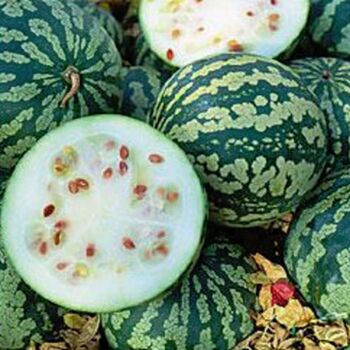
How to Grow Preserving Melon Seeds
Grow Guide #2342
Family: Cucurbitaceae
Binomial name: Citrullus vulgaris
Life Cycle: Annual
This 'How to Grow' guide details everything a home gardener needs to know to plant, grow and care for Preserving melon (Citrullus vulgaris).
When to Sow Preserving melon Seeds
Preserving melon is a warm season crop. Use the table below to identify the best time of year to sow preserving melon seeds in your climate.
| JAN | FEB | MAR | APR | MAY | JUN | JUL | AUG | SEP | OCT | NOV | DEC | |
|---|---|---|---|---|---|---|---|---|---|---|---|---|
| Cool | ||||||||||||
| Temperate | ||||||||||||
| Sub-Tropical | ||||||||||||
| Tropical | ||||||||||||
| Arid |
Preparation
Preserving melon plants are best grown in full sun. Choose a location that will receive at least 6 hours of full sun each day.
Preserving melon plants need a well drained soil enriched with plenty of organic matter. Prepare soil by weeding it thoroughly, digging it over to loosen it and adding aged animal manure or compost. Keep the area free of weeds until planting. Learn more about preparing soil for planting here.
How to Sow Preserving melon Seeds
Preserving melon seeds do not require any treatment (eg soaking, stratification) before sowing.
Preserving melon seeds grow best when they are sown directly into the garden.
- Sow seeds directly in the garden 20mm deep and 75cm apart, with rows 125cm apart.
- Keep soil moist but never wet or dry.
- Seeds should germinate in around 10-14 days at a soil temperature of 27-32°C.
- Young seedlings will need protection from pests, pets and weather until they are established.
Preserving melon is a tender crop that’s sensitive to frost. Do not transplant seedlings or sow seeds outside until all danger of frost has passed.
How to Grow Preserving melon
Preserving melon plants may need watering during the growing season. Water when the soil is dry about 5cm below the surface (test this by scratching away a little soil with your finger). Water deeply in the early morning or late afternoon. Avoid watering the leaves of plants to avoid fungal diseases. Learn more about watering here.
If soil was well prepared no extra fertiliser should be necessary. In poor soil or to give your plants an extra boost, application of a balanced fertiliser or one formulated for fruit and vegetables can be beneficial:
- Apply slow release fertiliser at the recommended rate when transplanting or when seedlings are 5-10cm tall.
- Apply liquid fertiliser at the recommended rate and frequency while plants are fruiting or flowering.
Vines can sprawl along the ground or be grown up a strong trellis. If growing on the ground, allow at least 2 square metres per plant. If growing on a trellis, plants will attach themselves using their tendrils but extra support can be provided by tying plants gently using twine or plant ties. Large fruit may need to be supported with a sling made from netting. Make sure you have the support in place when you sow seed or transplant seedlings to avoid disturbing the plant’s roots later.
Optional: pinch out the vine’s growing tip to manage the size of the plants and encourage fruit-bearing side shoots to form.
Tip: Mulch under ripening fruit with straw or sugar cane to help prevent rot.
How to Harvest Preserving melon
Preserving melon should be ready to harvest in approximately 80-100 days.
Fruit is ready to harvest when the stems become tough and woody or when the leaves on the plant are dry and brown. Harvest by cutting them from the vine or bush, leaving 5-10cm of stem attached to the fruit. To confirm ripeness, firmly tap each fruit and listen for a hollow sound, or look for a slight yellowing on the underside of fruit. Store harvested fruit in the fridge. Preserving melon is not eaten fresh but is used to make jams and preserves.
Common Problems when Growing Preserving melon
Like all plants, preserving melon is susceptible to some pests, diseases and other problems. Below is a list of the most common problems gardeners encounter when growing preserving melon plants:
 Aphids are small (2-4mm long) sap-sucking insects that congregate on the new shoots or the undersides of leaves. They can cause leaves to wilt or become discoloured, and also excrete honeydew which can attract ants and other insect pests. To manage aphids, remove them by spraying with a garden hose, apply a soap or alcohol spray, or encourage predatory insects to your garden. Read more about aphids here.
Aphids are small (2-4mm long) sap-sucking insects that congregate on the new shoots or the undersides of leaves. They can cause leaves to wilt or become discoloured, and also excrete honeydew which can attract ants and other insect pests. To manage aphids, remove them by spraying with a garden hose, apply a soap or alcohol spray, or encourage predatory insects to your garden. Read more about aphids here..jpg) Not setting fruit is a problem caused by lack of pollination. Flowers may fall off the plant or small fruit may form but then shrivel and rot. Wait until the plant is producing both male and female flowers. Use a paintbrush to transfer pollen from the male flowers to the female ones. Learn more about hand pollination here..
Not setting fruit is a problem caused by lack of pollination. Flowers may fall off the plant or small fruit may form but then shrivel and rot. Wait until the plant is producing both male and female flowers. Use a paintbrush to transfer pollen from the male flowers to the female ones. Learn more about hand pollination here.. Possums, birds and other animals can ruin a large percentage of your harvest overnight. Physically exclude pests by using netting or cages, or try spraying plants with a pungent homemade spray made from garlic, fish oil or mustard.
Possums, birds and other animals can ruin a large percentage of your harvest overnight. Physically exclude pests by using netting or cages, or try spraying plants with a pungent homemade spray made from garlic, fish oil or mustard..jpg) Powdery mildew is caused by fungal spores reproducing on the leaves of plants. First showing as white spots on leaves, affected areas can spread quickly to cover the entire leaf surface. While rarely fatal, powdery mildew can reduce yields. Water plants at soil level (not on leaves) to prevent spreading spores, allow good air flow between plants, remove affected leaves and if necessary spray with an appropriate fungicide or homemade spray. Read more here about powdery mildew here.
Powdery mildew is caused by fungal spores reproducing on the leaves of plants. First showing as white spots on leaves, affected areas can spread quickly to cover the entire leaf surface. While rarely fatal, powdery mildew can reduce yields. Water plants at soil level (not on leaves) to prevent spreading spores, allow good air flow between plants, remove affected leaves and if necessary spray with an appropriate fungicide or homemade spray. Read more here about powdery mildew here. Sunscald will show up on fruit as white marks or blisters that often become moudly. Young, unripe fruit are most susceptible. Do not prune leaves from plants at the height of summer; leaves will help to shade and protect the fruit. Cover plants with a light fabric on very hot days to protect them from sunburn.
Sunscald will show up on fruit as white marks or blisters that often become moudly. Young, unripe fruit are most susceptible. Do not prune leaves from plants at the height of summer; leaves will help to shade and protect the fruit. Cover plants with a light fabric on very hot days to protect them from sunburn.


.png)



